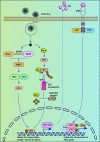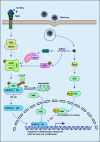Current progress on innate immune evasion mediated by Npro protein of pestiviruses
- PMID: 37090696
- PMCID: PMC10115221
- DOI: 10.3389/fimmu.2023.1136051
Current progress on innate immune evasion mediated by Npro protein of pestiviruses
Abstract
Interferon (IFN), the most effective antiviral cytokine, is involved in innate and adaptive immune responses and is essential to the host defense against virus invasion. Once the host was infected by pathogens, the pathogen-associated molecular patterns (PAMPs) were recognized by the host pattern recognition receptors (PRRs), which activates interferon regulatory transcription factors (IRFs) and nuclear factor-kappa B (NF-κB) signal transduction pathway to induce IFN expression. Pathogens have acquired many strategies to escape the IFN-mediated antiviral immune response. Pestiviruses cause massive economic losses in the livestock industry worldwide every year. The immune escape strategies acquired by pestiviruses during evolution are among the major difficulties in its control. Previous experiments indicated that Erns, as an envelope glycoprotein unique to pestiviruses with RNase activity, could cleave viral ss- and dsRNAs, therefore inhibiting the host IFN production induced by viral ss- and dsRNAs. In contrast, Npro, the other envelope glycoprotein unique to pestiviruses, mainly stimulates the degradation of transcription factor IRF-3 to confront the IFN response. This review mainly summarized the current progress on mechanisms mediated by Npro of pestiviruses to antagonize IFN production.
Keywords: immune evasion; innate immunity; interferon (IFN); pestivirus; viral proteins.
Copyright © 2023 Wen, Li, Lv, Liu, Ren, Zhai and Song.
Conflict of interest statement
The authors declare that the research was conducted in the absence of any commercial or financial relationships that could be construed as a potential conflict of interest.
Figures


Similar articles
-
Pestiviruses infection: Interferon-virus mutual regulation.Front Cell Infect Microbiol. 2023 Mar 2;13:1146394. doi: 10.3389/fcimb.2023.1146394. eCollection 2023. Front Cell Infect Microbiol. 2023. PMID: 36936761 Free PMC article. Review.
-
Fifty Shades of Erns: Innate Immune Evasion by the Viral Endonucleases of All Pestivirus Species.Viruses. 2022 Jan 27;14(2):265. doi: 10.3390/v14020265. Viruses. 2022. PMID: 35215858 Free PMC article.
-
Advances on Innate Immune Evasion by Avian Immunosuppressive Viruses.Front Immunol. 2022 May 12;13:901913. doi: 10.3389/fimmu.2022.901913. eCollection 2022. Front Immunol. 2022. PMID: 35634318 Free PMC article. Review.
-
HIV-1, interferon and the interferon regulatory factor system: an interplay between induction, antiviral responses and viral evasion.Cytokine Growth Factor Rev. 2012 Aug-Oct;23(4-5):255-70. doi: 10.1016/j.cytogfr.2012.06.001. Epub 2012 Jun 27. Cytokine Growth Factor Rev. 2012. PMID: 22748237 Review.
-
Disruption of interferon-β production by the Npro of atypical porcine pestivirus.Virulence. 2021 Dec;12(1):654-665. doi: 10.1080/21505594.2021.1880773. Virulence. 2021. PMID: 33538238 Free PMC article.
Cited by
-
Network of Interactions between the Mut Domains of the E2 Protein of Atypical Porcine Pestivirus and Host Proteins.Genes (Basel). 2024 Jul 27;15(8):991. doi: 10.3390/genes15080991. Genes (Basel). 2024. PMID: 39202352 Free PMC article.
-
Safety and DIVA Capability of Novel Live Attenuated Classical Swine Fever Marker Vaccine Candidates in Pregnant Sows.Viruses. 2024 Jun 28;16(7):1043. doi: 10.3390/v16071043. Viruses. 2024. PMID: 39066207 Free PMC article.
References
-
- Nettleton PF, Gilray JA, Russo P, Dlissi E. Border disease of sheep and goats. Vet Res (1998) 29:327–40. - PubMed
Publication types
MeSH terms
Substances
LinkOut - more resources
Full Text Sources

